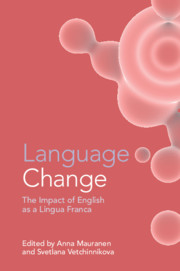Book contents
- Language Change
- Language Change
- Copyright page
- Contents
- Figures
- Tables
- Contributors
- Acknowledgements
- Abbreviations
- Introduction
- Part I Pooling Perspectives
- 1 Calling Englishes As Complex Dynamic Systems: Diffusion and Restructuring
- 2 English as a Lingua Franca in the Context of a Sociolinguistic Typology of Contact Languages
- 3 How Writing Changes Language
- 4 ELF and Translation As Language Contact
- 5 Present-Day Standard English
- 6 Beyond Language Change
- Part II Zooming in on ELF
- Index
- References
6 - Beyond Language Change
ELF and the Study of Sociolinguistic Change
from Part I - Pooling Perspectives
Published online by Cambridge University Press: 17 December 2020
- Language Change
- Language Change
- Copyright page
- Contents
- Figures
- Tables
- Contributors
- Acknowledgements
- Abbreviations
- Introduction
- Part I Pooling Perspectives
- 1 Calling Englishes As Complex Dynamic Systems: Diffusion and Restructuring
- 2 English as a Lingua Franca in the Context of a Sociolinguistic Typology of Contact Languages
- 3 How Writing Changes Language
- 4 ELF and Translation As Language Contact
- 5 Present-Day Standard English
- 6 Beyond Language Change
- Part II Zooming in on ELF
- Index
- References
Summary
In this chapter, I argue that the study of English as a lingua franca (ELF) can be fruitfully framed as the study of sociolinguistic change. In adopting a sociolinguistic change perspective, researchers who take an interest in ELF and change are invited to move beyond a focus on language change and to pursue a more comprehensive and holistic interest in the processes of social and linguistic change that arise from – and give rise to – the contemporary widespread use of English as a lingua franca. I illustrate the argument by providing examples from research into the internationalization of Danish universities since the late 1990s, showing how the introduction of ELF as a language of teaching and learning involves change in multiple dimensions, including language ideology, discursive practices and social norms.
Keywords
- Type
- Chapter
- Information
- Language ChangeThe Impact of English as a Lingua Franca, pp. 152 - 174Publisher: Cambridge University PressPrint publication year: 2020
References
- 4
- Cited by

